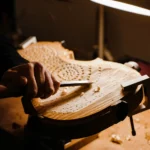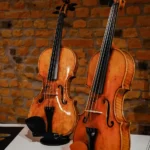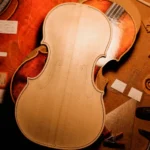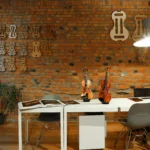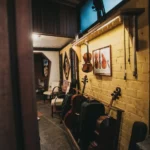Which Are The Best Violin Bows?
Back to BlogWhat kind of bow should you use for your violin? There are so many choices it can be very overwhelming. You want to make sure that you get a bow that will sound good, be easy to play, and won’t break the bank.
The key is to know what you should look for when choosing a bow for your violin. If you don’t know much about bows, you may tend to go with something that just looks nice rather than what is best for your needs.
In the end, the answer to the question of which is the best bow for violins is: it depends! It will depend on your age, your experience, your musical style, and your instrument as well. Some are better suited for beginner students, while others work for more advanced players.
We understand it is not an easy decision, so let’s break down a few key features and considerations you need to know and make along the way…
An excellent violin bow can…
Get another 30 to 40% out of a good violin and bring out ”the voice” of the instrument. A bow emphasizes the overtones in the sound that are very special.
Let’s start by saying what makes a good bow. Do you know the answer?
It will be a good violin bow if it feels comfortable, lightweight, and well-balanced for you. So while you play with it, make sure it doesn’t feel too light or too heavy, neither too weak nor too soft; it should be flexible yet well-balanced.
The average violin bow weighs 60 grams, but the weight cannot determine if it is a good bow or not since this is more a matter of preference. Violinists can play beautifully with bows weighing as low as 54 grams, while others prefer super heavy ones up to 68 grams.
The material of violin bows
The quality of the material used in a bow impacts its ability to play. Wood bows are the best option for a violinist. Brazilwood, commonly known as pernambuco wood, has been vital in the manufacture of fine violin bows and other stringed instruments since Mozart was composing his masterpieces in Vienna.
Let’s go back in time to understand how it all started!
Frenchmen François Tourte (1747-1835) revolutionized the art of bow making for violin and other string instruments, using brazilwood and setting the shape and curvature of the modern bow.
He was the one who bent the bow’s wood in the opposite direction, in a way that the horsehair tension remains unchanged when the musician presses the bow against the strings of an instrument. He was also responsible for the choice of wood, Brazilwood, that provides a combination of physical attributes such as stiffness, flexibility, and the ability to maintain the curvature.
Pernambuco wood had been essential in making fine stringed instruments bows ever since its introduction 250 years ago. Its combination of hardness, flexibility, density, and sheer beauty, matched with the unique ability to maintain a fixed curve, results in a truly exceptional bow.⠀
Nowadays, this tree is only found in remnants of the coastal forests of Brazil and appears on the list of plant species threatened with extinction. Currently, all bows made out of brazilwood have their origins from old wood stocks as it is not allowed to cut this species in nature anymore.⠀
When buying a bow, make sure they are only made with certified brazilwood. The CITES certificate ensures that international trade in specimens of wild animals and plants does not threaten their survival. Here at Amorim Fine Violins, all bows are provided with this certificate.
SIGN UP TO OUR NEWSLETTER
Keep in the loop with all our latest updates!
How to choose the best violin bow: tips for you
When looking for a violin bow, make sure you take your skill level and playing style into consideration. Don’t forget that to achieve your full potential you need an excellent instrument in one hand but also an EXCELLENT BOW in the other!
Here are some tips from Lucchi, a legendary family of bow makers from Cremona. With many years of experience, they have helped many musicians find their ideal bow, let’s see what they have to say to help you!
As many may think, it is not necessary to try a bow in a concert, you can easily make some evaluations even comfortably from your home. Mainly, our advice is to feel how the adherence is to the tip, using the bow in different situations:
- Pianissimo
- At the tip (last 4 cm)
- Hollow string (without vibrato as this helps the string to start)
- Fourth string (the most difficult to vibrate)
- Close to the bridge (only the bows with excellent material can obtain good results in this position)
It is often believed that a bow with a heavy head makes a good grip on the string. This is absolutely wrong: in fact, there are very light bows, which have a wonderful grip, and others that are heavy and do not. If you test the grip throughout the bow, you notice that the contact on the frog is quite easy to obtain, because the position is very close to the hand.
When we move away from the frog we feel the characteristics of that bow better:
At the center:
When you move towards the center of the bow, three different components will come to play: the quality of the wood, the taper of the stick, and the type of curve.
At the tip:
When moved towards the tip, the components listed above are even more important since the entire stick, the entire curve and all the thicknesses are put under strain. So if there are imperfections in these components, more defects are highlighted here than playing in other parts of the bow.
Therefore, by trying the five points listed above at the same time, it is not necessary to listen to the sound quality emitted, but mainly the grip on the string. Only a bow with good wood quality, a perfect curve, the right stick thickness and good hair quality can have a good grip.
While an expert in the field can recognize these parameters simply by viewing the bow, the musician is often attracted to some characteristics of the bow that do not determine its goodness, such as the color of the wood, the hair, the setting, etc …
It is essential to stretch the horsehair as much as the bow requires: when playing, the stick must not touch the horsehair but it must not create an exaggerated space, which will tend to distort the quality of the bow and sound.
With these brief indications, the musician can really know if the bow will be able to respond to the high technical and sound qualities necessary for his/her performance. In fact, excellent adherence to the tip means that the sound produced will reach far away bouncing off the walls and then returning to the performer (feedback sound).
Lucchimeter: Speed of Sound
Have you ever heard about the LucchiMeter?
The LucchiMeter is an ultrasound tester that measures the acoustic characteristics of wood. More precisely, it measures the time needed for the sound waves to pass through the material. With this data, the elasticity, as well as the sound quality, can be determined.
The tester can measure the unworked wood, during the working phases and even in the finished instrument. For violins, guitars, pianos, oboes, clarinets, harps, reed instruments, or bows. Moreover, the LucchiMeter is used in the world of artisans, schools of violin making, institutes of acoustic research, and important foundations such as the Taiwanese Chi Mei Foundation.
And how does it work? The impulses set the wood vibrating, and the tester measures the time the wave takes to move from one end to another. Knowing the length of the piece to be tested, one obtains the speed of the sound.
Giovanni Lucchi quickly turned to science to find concrete answers to his experimental discoveries and investigate the causes of a result that often appeared to be clear. He therefore patented the LucchiMeter, the tester that measures the acoustic properties of materials, and he invented LucchiSound, which identifies the important harmonics that produce “beautiful sound.”
The perfect match between a musician and a bow is: when the bow flows with you as you play, it gives you confidence and allows you to play with less effort. The bow needs to become an extension of your hand so you can always perform better.
Violinists are always looking for ways to improve their playing skills and their instruments. Everything about making music is interconnected, so improving your bow is essential for enhancing your violin-playing.
Please take a look at our fine collection of violin bows, responsive and balanced, allowing the musician to bring the best music possible from their instrument.
Violin Bow by Giovanni Lucchi, Silver Special
This bow’s characteristics are the high-quality round Pernambuco stick of light color, plain ebony and silver frog with an insertion of a Swarovski crystal, three-part silver and ebony screw, and silver and synthetic fiber winding.
Violin Bow by Marta Lucchi, Silver Mounted, Black
This bow’s characteristics are the high-quality round Pernambuco stick of light color, Parisian eye silver mounted frog, three-part silver and ebony screw, and silver and synthetic fiber winding.
€8,000 EUR ( 22% VAT included)





